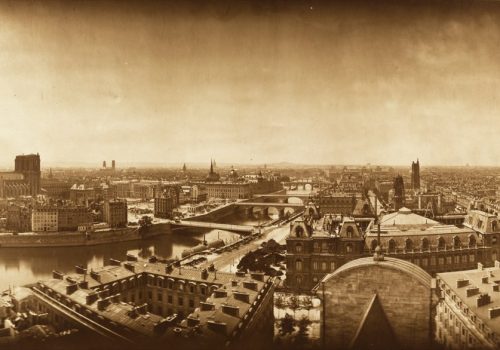From February 17 through May 14, 2018, the Musée Unterlinden in Colmar is presenting a retrospective dedicated to photographer Adolphe Braun (1812-1877). Braun was one of the most influential photographers of the 19th century. Today, The Eye of Photography presents his Panoramic series.
The popularity of panoramic views in the 19th century led Braun to be interested in the images. His first panoramas are constituted of many photographs taken from the same viewpoint and put together in a continuous image. In 1862 in London, John R. Johnson and John A. Harrison invented a new panoramic camera, the Pantoscopic Camera, made in Paris by the English engineer David Hunter Brandon. In 1865, Braun bought a fifth of the invention’s usage rights.
The new device allowed for the automatic recording of a panoramic image. Operated by a clock mechanism, the chamber and the negative turn horizontally from left to right in a synchronized and continuous motion. The frame plate passes on a rail, while a shutter placed in front of the camera controls the exposure time by obscuring the gap letting light pass. Because of the exposure duration of two or three minutes, which can be manually increased or decreased, people have the time to change places and be photographed several times.
Adolphe Braun had already acquired the reputation of being a landscape photography expert, especially of the high mountains. Equipped with this camera, his photographers were responsible for creating panoramas, first in Switzerland, in the French Alps, then in Italy. The Pantoscopic Camera allowed for shots of architecture and landscapes with a maximal amplitude of 130 degrees. The majority of Braun’s pictures were taken from an elevated position. Optic distortions of close-ups were caused by technical shortcomings. Certain shots show how difficult it was to position the camera in order to keep the foreground from being too dominant or the monuments from appearing miniature.
The technical limitations of Johnson and Harrison’s camera did not stop its commercial success. The public not only admired the beauty of the landscapes, but also admired the image format and the extremely precise rendering of detail that gave the viewers the illusion of being there.
Close to 500 different panoramic photos have been kept. We can find those of Paris during the Exposition Universelle of 1867. The selection took place according to the standards of painted and etched tourist pictures. The majority of panoramas show the Swiss villages and tourist sites around Lake Lugano or the lake des Quatre-Cantons. Among the tourist attraction sites, we also find the inns and hotels of Rigi, the summit offering one of the most beautiful views of the Lake des Quatre-Cantons . This mountain is one of the main Alpine tourism destinations, made famous in English-speaking countries by the description that Mark Twain made of his ascent. The photographs of Alpine landscapes are enthusiastically welcomed by British tourists and mountaineers, who, since the 1860s, have been visiting the Berner Oberland and the Chamonix region, hiring the services of the Thomas Cook agency. Another series of panoramas was photographed in Italy beginning in 1867 by Adolphe Braun’s son, Gaston. It consists of photos of Florence, Fiesole, Milan, Naples, and Pompeii.
Adolphe Braun, Photographic Adventures
From February 17 through May 14, 2018
Musée Unterlinden
1 Rue des Unterlinden
68000 Colmar
France
http://www.musee-unterlinden.com/
Exhibition Catalogue (versions in French and German)
Adolphe Braun – Une entreprise photographique européenne au 19e siècle
Published by Editions Schirmer / Mosel
260 pages (French version) 35 €
360 pages (German version) 58 €
















